

Abstract Art: Definition, History, Types, Characteristics. Surrealist and Organic Abstraction In parallel with the development of geometric-style concretism, during the 1920s and 1930s, exponents of Surrealism began to produce a range of fantasy-like, quasi-naturalistic images.
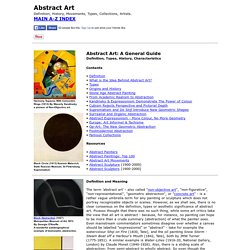
The leading exemplars of this style of Biomorphic/Organic Abstraction were Jean Arp and Joan Miro, neither of whom - as their many preparatory sketches confirm - relied on the technique of automatism. Their fellow Surrealist Salvador Dali (1904-89) also produced some extraordinary paintings like The Persistence of Memory (1931, MoMA, NY) and Soft Construction with Boiled Beans (1936, Philadelphia Museum of Art). Jean Arp was also an active sculptor who specialized in Organic Abstraction, as did the English sculptors Henry Moore (1898-1986) and Barbara Hepworth (1903-1975). (See: Modern British Sculpture 1930-70.)
Shibboleth Authentication Request. Shibboleth Authentication Request. The Philosophy of Music (Stanford Encyclopedia of Philosophy/Winter 2007 Edition) First published Mon 22 Oct, 2007 Philosophy of music is the study of fundamental questions about the nature of music and our experience of it.
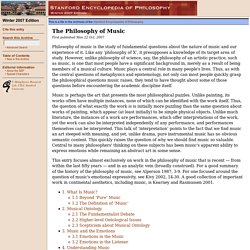
Like any ‘philosophy of X’, it presupposes a knowledge of its target area of study. However, unlike philosophy of science, say, the philosophy of an artistic practice, such as music, is one that most people have a significant background in, merely as a result of being members of a musical culture. Music plays a central role in many people's lives. Thus, as with the central questions of metaphysics and epistemology, not only can most people quickly grasp the philosophical questions music raises, they tend to have thought about some of those questions before encountering the academic discipline itself.
Music is perhaps the art that presents the most philosophical puzzles. This entry focuses almost exclusively on work in the philosophy of music that is recent — from within the last fifty years — and in an analytic vein (broadly construed). 1. 2. 3. Shibboleth Authentication Request. UFOs and Extraterrestrials in Art History. UFOs and Extraterrestrials in Art History The Historical Record of Planet Earth speaks of ongoing contact with extraterrestrials as found in oral traditions, tablets, stone monuments, petroglyphs, and art forms found throughout the planet.
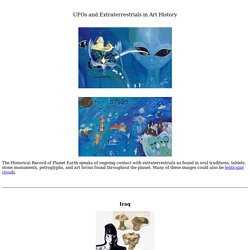
Many of these images could also be lenticular clouds. Iraq Reptilian looking entities found in Iraq - 5,000-4,500 BC. Sumerian Gods Art Exhibit British Museum #52 Sumerian Gods - Scroll Through The Images. Michelangelo on Struggle and Creative Integrity. By Maria Popova Italian Renaissance sculptor, painter, poet, architect, and engineer Michelangelo (March 6, 1475–February 18, 1564) is celebrated as one of the greatest and most influential artists of all time.
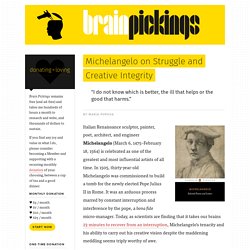
In 1505, thirty-year-old Michelangelo was commissioned to build a tomb for the newly elected Pope Julius II in Rome. It was an arduous process marred by constant interruption and interference by the pope, a bona fide micro-manager. Today, as scientists are finding that it takes our brains 23 minutes to recover from an interruption, Michelangelo’s tenacity and his ability to carry out his creative vision despite the maddening meddling seems triply worthy of awe. Indeed, he knew value of undisturbed creative labor and protected it fiercely, unafraid to stand up to the most powerful man in Europe. If I stayed in Rome, my own tomb would be made before the pope’s. Postmodernism Dictionary. It is important to discuss how definitions is approached from a postmodern perspective.
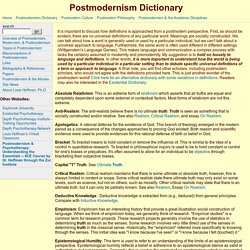
First, as should be evident, there are no universal definitions of any particular word. Meanings are socially constructed. We can talk about how a word is generally used or used by a particular individual, but we can't talk about a universal approach to language. Furthermore, the same word is often used different in different settings (Wittgenstein's Language Games). This makes language and communication a complex process with lacks the certainly assumed in modernity and premodernity. Absolute Relativism: This is an extreme form of relativism which asserts that all truths are equal and completely dependent upon some external or contextual factors. Anti-Realism: The anti-realists believe there is no ultimate truth. Apologetics: A rational defense for the existence of God. Bracket: To bracket means to hold constant or remove the influence of. Capital "T" Truth: See Ultimate Truth. Does God exist?
Fors clavigera: letters to the workmen and labo... William Morris - Art and Labour. Art and Labour I must first tell you what I mean by the words Art and Labour; and first, by art I mean something wider than is usually meant by the word, something which I fear it is not very easy to explain to some of you born and bred in this great manufacturing city, and living under conditions which I will say would have made art impossible to be if men had always lived so.
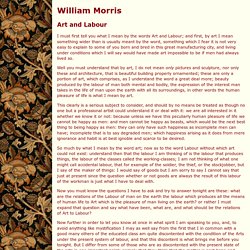
Well you must understand that by art, I do not mean only pictures and sculpture, nor only these and architecture, that is beautiful building properly ornamented; these are only a portion of art, which comprises, as I understand the word a great deal more; beauty produced by the labour of man both mental and bodily, the expression of the interest man takes in the life of man upon the earth with all its surroundings, in other words the human pleasure of life is what I mean by art.
But what followed? But revolution was in store for it no less than for the classical system. Or high wages? Bibliographical Note Title.